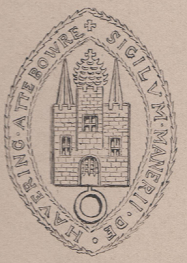Royal Liberty of Havering
| Havering Havering-atte-Bower |
|
|---|---|
| Area | |
| • 1831 | 12,550 acres (50.8 km2) |
| • 1892 | 12,550 acres (50.8 km2) |
| Population | |
| • 1831 | 6,812 |
| History | |
| • Origin | Hornchurch parish in the Becontree Hundred of Essex |
| • Created | 12th century |
| • Abolished | 1 July 1892 |
| • Succeeded by | Reincorporated with Essex |
| Status |
Royal manor (11th century–1828) Liberty (1465–1892) |
| Government | Havering Quarter Sessions |
| • HQ | Court House, Market Place, Romford |
 Seal of Havering |
|
| Subdivisions | |
| • Type | Chapelries (later became parishes) |
| • Units |
|
 Three parishes of the liberty in 1881 |
|
Havering, also known as Havering-atte-Bower, was a royal manor and ancient liberty whose former area now forms part of, and gives its name to, the London Borough of Havering in Greater London. The manor was in the possession of the Crown from the 11th to the 19th centuries and was the location of Havering Palace from the 13th to the late 17th century. It occupied the same area as the ancient parish of Hornchurch which was divided into the three chapelries of Havering, Hornchurch and Romford.
The name Havering is recorded in the 1086 Domesday Book as Haueringas and means 'the settlement of the family or followers of a man called Hæfer', an ancient folk name. From the 13th century the suffix -atte-Bower was added and means 'at the royal residence'.Havering and Havering-atte-Bower continue to be used as the names of a London borough and a small settlement respectively.
A liberty was formed by charter for the royal manor of Havering in 1465. The manor was an ancient demesne that had formed part of the Becontree hundred of Essex. The area surrounding the royal manor house of Havering Palace had enjoyed special status since the 13th century and the liberty charter issued in 1465 by King Edward IV reconfirmed many existing rights. The event was celebrated by the issue of a copper token for currency in the late 18th century, which uniquely among the many coins of that era bears the date 1465. The charter gave residents of the area freedom from taxation, its own local magistrates and gaol, and, earlier, freedom from the service of writs by the Essex Quarter Sessions. The famous Romford Market was another privilege that was guaranteed under this arrangement.
...
Wikipedia
